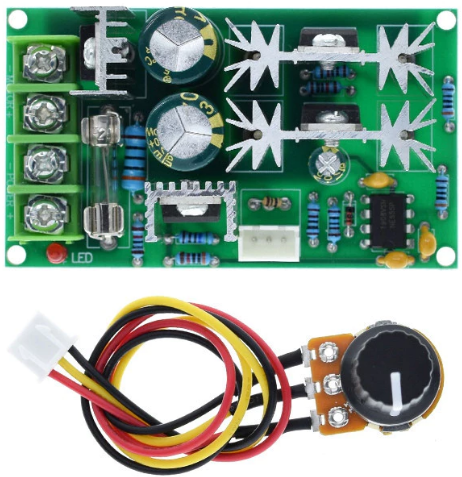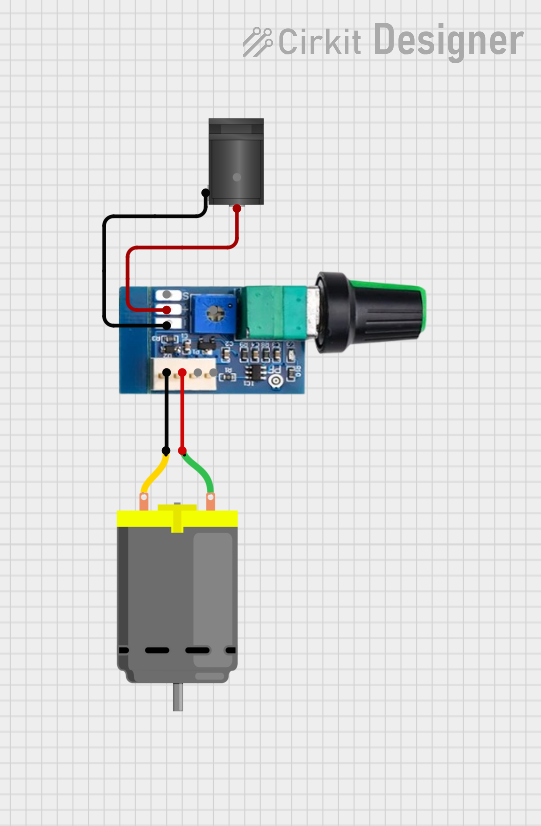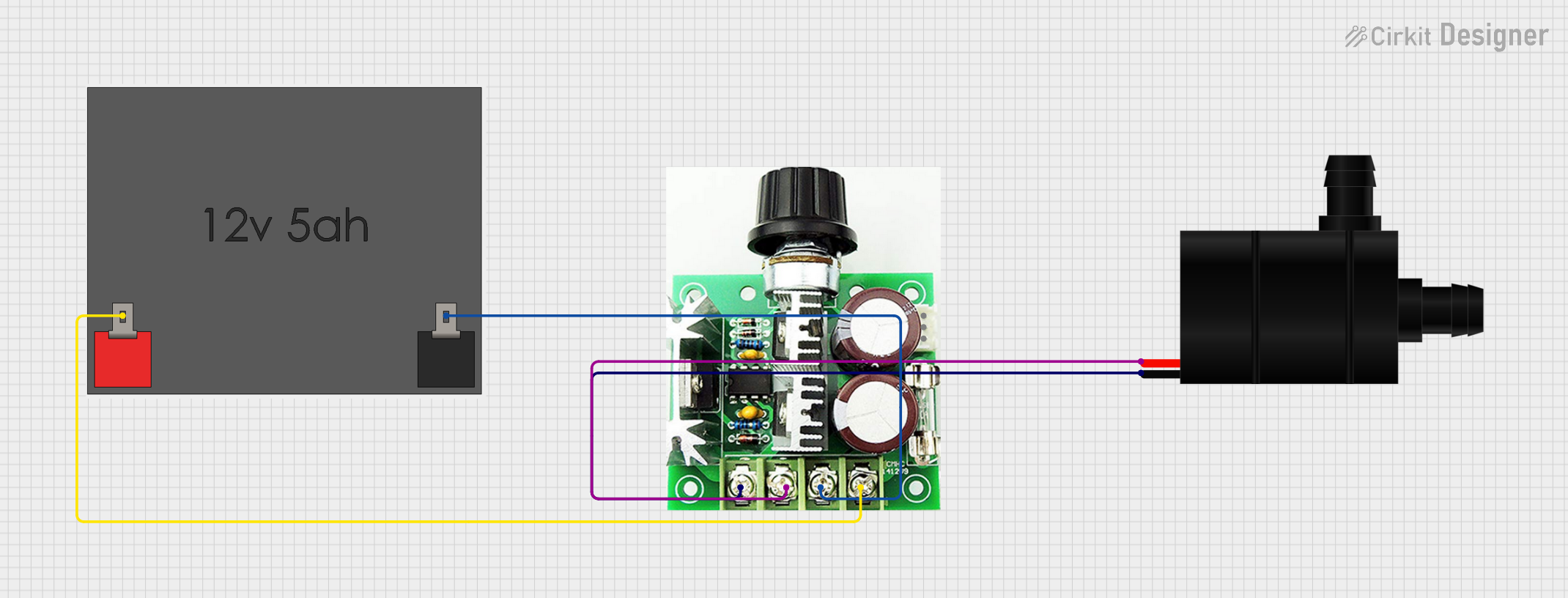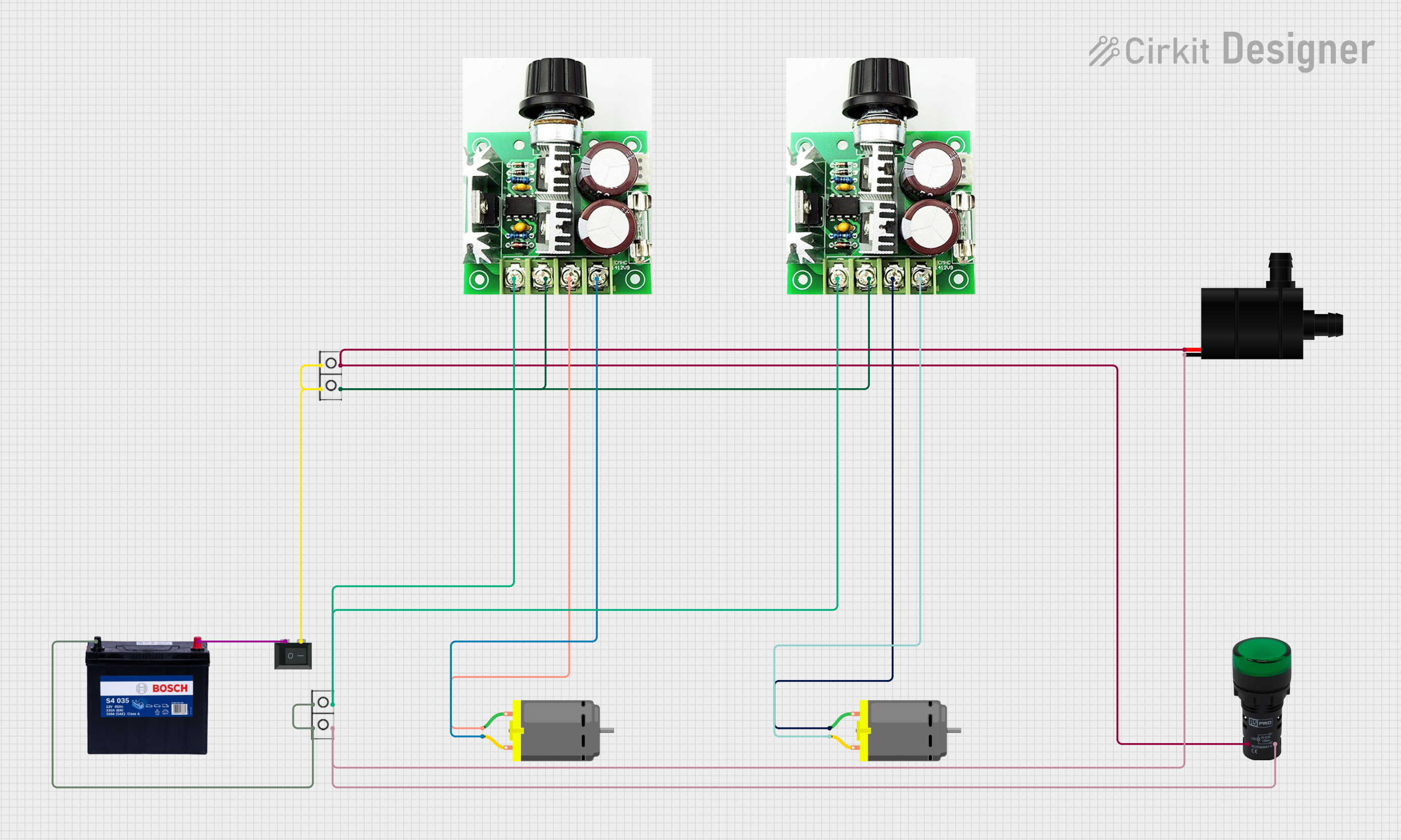
How to Use PWM DC Motor Speed Control 10-60V - 20A: Examples, Pinouts, and Specs

 Design with PWM DC Motor Speed Control 10-60V - 20A in Cirkit Designer
Design with PWM DC Motor Speed Control 10-60V - 20A in Cirkit DesignerIntroduction
The PWM DC Motor Speed Control 10-60V - 20A is a versatile and efficient controller designed to regulate the speed of DC motors using Pulse Width Modulation (PWM) technology. It operates within a voltage range of 10-60V and supports a maximum current of 20A, making it suitable for a wide range of motor control applications. By adjusting the duty cycle of the PWM signal, this controller allows precise control over motor speed while maintaining high efficiency.
Explore Projects Built with PWM DC Motor Speed Control 10-60V - 20A

 Open Project in Cirkit Designer
Open Project in Cirkit Designer
 Open Project in Cirkit Designer
Open Project in Cirkit Designer
 Open Project in Cirkit Designer
Open Project in Cirkit Designer
 Open Project in Cirkit Designer
Open Project in Cirkit DesignerExplore Projects Built with PWM DC Motor Speed Control 10-60V - 20A

 Open Project in Cirkit Designer
Open Project in Cirkit Designer
 Open Project in Cirkit Designer
Open Project in Cirkit Designer
 Open Project in Cirkit Designer
Open Project in Cirkit Designer
 Open Project in Cirkit Designer
Open Project in Cirkit DesignerCommon Applications and Use Cases
- Electric vehicles and scooters
- Conveyor belts and industrial automation
- Robotics and hobbyist projects
- Fans, pumps, and other motor-driven devices
- Renewable energy systems (e.g., solar-powered motors)
Technical Specifications
The following table outlines the key technical details of the PWM DC Motor Speed Control 10-60V - 20A:
| Parameter | Specification |
|---|---|
| Input Voltage Range | 10V to 60V DC |
| Maximum Current | 20A |
| PWM Frequency | 15 kHz |
| Duty Cycle Range | 0% to 100% |
| Control Method | Potentiometer (manual) |
| Efficiency | ≥ 90% |
| Operating Temperature | -20°C to 50°C |
| Dimensions | 85mm x 56mm x 28mm |
| Weight | ~120g |
Pin Configuration and Descriptions
The controller typically has the following input/output terminals:
| Pin/Terminal | Description |
|---|---|
| VIN+ | Positive input voltage terminal (10-60V DC) |
| VIN- | Negative input voltage terminal (ground) |
| MOTOR+ | Positive output terminal for the DC motor |
| MOTOR- | Negative output terminal for the DC motor |
| Potentiometer | Speed control knob for adjusting the PWM duty cycle |
Usage Instructions
How to Use the Component in a Circuit
Connect the Power Supply:
- Attach the positive terminal of your DC power supply to the
VIN+terminal. - Connect the negative terminal of your DC power supply to the
VIN-terminal. - Ensure the input voltage is within the 10-60V range.
- Attach the positive terminal of your DC power supply to the
Connect the DC Motor:
- Connect the positive terminal of the DC motor to the
MOTOR+terminal. - Connect the negative terminal of the DC motor to the
MOTOR-terminal.
- Connect the positive terminal of the DC motor to the
Adjust the Speed:
- Use the potentiometer to adjust the motor speed. Turning the knob clockwise increases the speed, while turning it counterclockwise decreases the speed.
Power On:
- Turn on the power supply. The motor should start running, and its speed can be controlled using the potentiometer.
Important Considerations and Best Practices
- Current Rating: Ensure the motor's current draw does not exceed 20A. Use a fuse or circuit breaker for added protection.
- Heat Dissipation: The controller may generate heat during operation. Use proper ventilation or a heatsink if necessary.
- Polarity: Double-check the polarity of all connections to avoid damage to the controller or motor.
- Voltage Range: Do not exceed the 60V input voltage limit to prevent damage to the controller.
Example: Connecting to an Arduino UNO
While this controller is primarily designed for manual control via the potentiometer, it can also be interfaced with an Arduino UNO for automated control. Below is an example of how to use the Arduino to generate a PWM signal to control the motor speed:
Circuit Setup
- Remove the potentiometer from the controller.
- Connect the Arduino's PWM output pin (e.g., pin 9) to the signal input of the controller.
- Connect the Arduino's ground (GND) to the controller's ground (VIN-).
Arduino Code
// Example code to control motor speed using Arduino PWM
// Connect the PWM pin (e.g., pin 9) to the controller's signal input
const int pwmPin = 9; // PWM output pin connected to the controller
void setup() {
pinMode(pwmPin, OUTPUT); // Set the PWM pin as an output
}
void loop() {
// Gradually increase motor speed
for (int speed = 0; speed <= 255; speed++) {
analogWrite(pwmPin, speed); // Write PWM signal (0-255)
delay(20); // Wait 20ms for smooth acceleration
}
// Gradually decrease motor speed
for (int speed = 255; speed >= 0; speed--) {
analogWrite(pwmPin, speed); // Write PWM signal (0-255)
delay(20); // Wait 20ms for smooth deceleration
}
}
Troubleshooting and FAQs
Common Issues and Solutions
Motor Does Not Start:
- Cause: Incorrect wiring or insufficient input voltage.
- Solution: Verify all connections and ensure the input voltage is within the 10-60V range.
Motor Runs at Full Speed Regardless of Potentiometer Position:
- Cause: Faulty potentiometer or incorrect connection.
- Solution: Check the potentiometer wiring or replace it if necessary.
Controller Overheats:
- Cause: Excessive current draw or poor ventilation.
- Solution: Ensure the motor's current does not exceed 20A and improve heat dissipation.
PWM Signal from Arduino Not Working:
- Cause: Incorrect PWM pin or signal level.
- Solution: Verify the Arduino code and ensure the PWM pin is correctly connected.
FAQs
Can I use this controller with a 24V motor?
- Yes, as long as the input voltage is within the 10-60V range and the motor's current does not exceed 20A.
Is reverse motor direction supported?
- No, this controller does not support reversing the motor direction. Use an H-bridge circuit for bidirectional control.
Can I use this controller with a battery?
- Yes, ensure the battery voltage is within the supported range (10-60V).
What happens if I exceed the 20A current limit?
- Exceeding the current limit may damage the controller. Use a fuse or circuit breaker for protection.